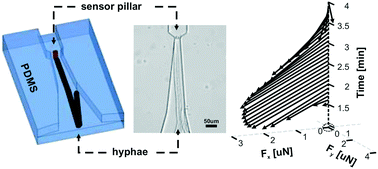An elastomeric micropillar platform for the study of protrusive forces in hyphal invasion†
Abstract
Oomycetes and fungi are microorganisms whose pathogenic (invasive) growth can cause diseases that are responsible for significant ecological and economic losses. Such growth requires the generation of a protrusive force, the magnitude and direction of which involves a balance between turgor pressure and localised yielding of the cell wall and the cytoskeleton. To study invasive growth in individual hyphae we have developed a lab-on-a-chip platform with integrated force-sensors based on elastomeric polydimethylsiloxane (PDMS) micro-pillars. With this platform we are able to measure protrusive force (both magnitude and direction) and hyphal morphology. To show the usefulness of the platform, the oomycete Achlya bisexualis was inoculated and grown on a chip. Growth of individual hyphae into a micro-pillar revealed a maximum total force of 10 μN at the hyphal tip. The chips had no discernible effect on hyphal growth rates, but hyphae were slightly thinner in the channels on the chips compared to those on agar plates. When the hyphae contacted the pillars tip extension decreased while tip width increased. A. bisexualis hyphae were observed to reorient their growth direction if they were not able to bend and effectively grow over the pillars. Estimates of the pressure exerted on a pillar were 0.09 MPa, which given earlier measures of turgor of 0.65 MPa would indicate low compliance of the cell wall. The platform is adaptable to numerous cells and organisms that exhibit tip-growth. It provides a useful tool to begin to unravel the molecular mechanisms that underlie the generation of a protrusive force.



 Please wait while we load your content...
Please wait while we load your content...